Posted by MiriamEllis
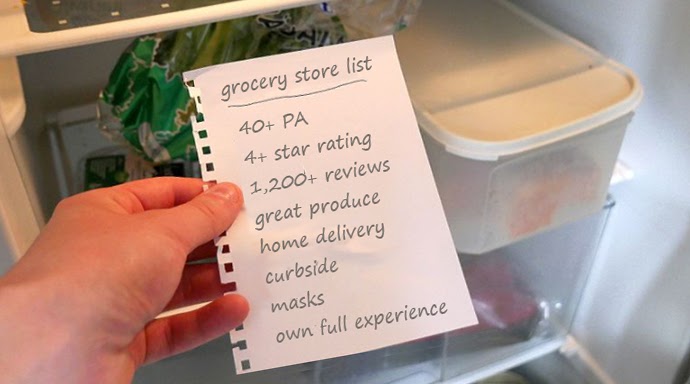
Grocery stores belong at the center of the 2021 local SEO industry conversation.
Other than medical facilities, no enterprise stands out more clearly on the map as essential to daily life in the US, and few verticals have had to adapt more rapidly in mid-flight than our neighborhood food stores in the COVID-19 era. From independent grocers to major supermarket chains, there are heroes in every aisle keeping the nation fed. Any data that supports the strong continuance of these businesses is well worth sharing.
In this article, I’ll provide results from 900 data points I pulled while analyzing the top local-pack-ranked grocery store in each of the 50 US capital cities. I’ll also summarize the practical tactics I’ve learned from listening to grocers and their marketers, highlighting how they’re adapting and succeeding in unprecedented times.
It’s my hope that both in-house and agency grocery marketers will discover important takeaways in my analysis to ensure a successful 2021 for each vital store.
Methodology
I manually queried Google for “grocery store”, modified with the city name of each of the 50 US capital cities. I was not physically located in any of the cities where I searched, which should exclude the influence of user-to-business proximity. In a spreadsheet, I manually recorded 18 characteristics for each of the winning grocery stores, and then drew my statistics from this data.
The GMB characteristics of top-ranked grocery stores
Review these statististics to assess how a grocery store you’re marketing measures up.
Location within city limits
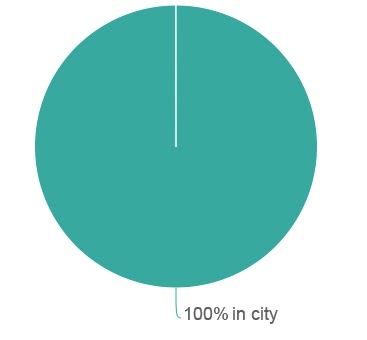
100% of the grocery stores ranking #1 had a physical location within the city limits of the specified search phrase city. No shop, however strong, was getting the number one spot in the local pack if it wasn’t within the city.
Takeaway: Having a location within city limits correlates with a good chance of ranking for searches that contain that city’s name.
Keywords in business title
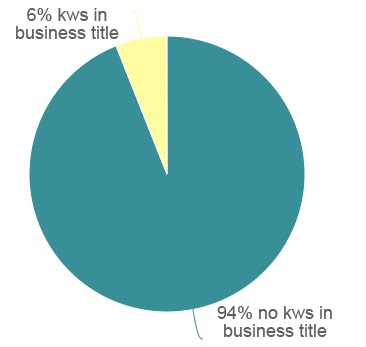
Only 6% of the top-ranked businesses had business titles that matched any part of my search phrases. This was good to see, given Google’s known (and unfortunate) rewarding of brands that stuff keywords into their business titles in violation of Google’s guidelines. I saw only one business that had extraneous keywords in its title.
Takeaway: You don’t need to spam Google with keywords in your business title to rank as a top grocery store.
Brand diversity
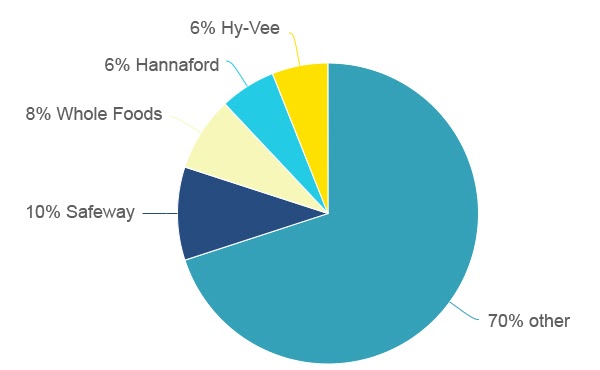
No one brand is winning the top spot across the country. Results were extremely diverse, and made up of a vibrant mix of independent grocers and large chains. Some brands were winning out in more than one state, however. Safeway won five local packs, Whole Foods won four, and Hy-Vee and Hannaford each won three. Beyond this, brands were very varied.
Takeaway: Any brand, large or small, can compete for premium local visibility. No one brand has a monopoly on rankings.
Page Authority of GMB landing page
Page Authority (PA) is a 100-point score developed by Moz that predicts how well a specific website page will rank within search engine results. PA is believed to exert a strong influence on local pack rankings.
Examining the PA of the website landing page linked to from each grocery store’s Google My Business listing, I found that the average PA was 40. The highest PA was 58 and the lowest was 26. Five of the top-ranked supermarkets had no website link at all, amazingly, and this must be a source of mystery and frustration for lower-ranked grocery stores in these cities with GMB listings that do link to their websites.
Takeaway: An average PA of 40 is not prohibitively high. Using Moz Pro to measure competitive PA and actively seeking relevant local links for each location of a grocery brand can help you beat out sleepier competitors. When low PA or even a missing website link are still being rewarded with a high ranking for a competitor of the brand you’re marketing, it’s time to conduct a local business audit to discover which other local search ranking factors might be at play.
Primary GMB category

82% of top-ranked grocery stores use “grocery store” as their primary category. The remainder of brands had chosen a few other categories, like “supermarket” or “organic food store”. The primary category chosen for the GMB listing is believed to have the most impact on which terms the business ranks for in Google’s local packs.
Takeaway: “Grocery store” has a much higher estimated monthly search volume than any other keyword phrase I investigated, such as “supermarket” or “food store”. Grocers wishing to rank for this top term are best off choosing “grocery store” as their primary GMB category.
Rating
The average rating of top-ranked grocery stores is 4.2 stars. The highest rated market had 4.7 stars, and the lowest had 3.6. Star ratings are believed to influence local rank.
Takeaway: No top-ranked grocery store had a perfect 5-star rating. Don’t be overly concerned about the occasional negative review, but do aim for customer satisfaction that yields ratings in the 4-star range, cumulatively.
Review count
Grocery stores receive a massive number of reviews, and review counts are believed to influence rank. Overall, the 50 grocery stores I analyzed had received a total of 62,415 reviews, indicating just how common usage of Google as a dominant consumer review platform has become.
The average review count per store location is 1,248. The count for the most-reviewed grocery store in my data set is 3,632. The fewest reviews a top-ranked store received is 227. Bear in mind that the reviews each store location needs to achieve maximum visibility will be predicated on their unique geographic market and level of competition.
Takeaway: The fact that the overwhelming majority of reviews I saw are unmanaged (have no brand responses) leads me to believe that professional review acquisition campaigns aren’t likely the force driving the high number of total reviews in the grocery industry. Rather, I’d suggest that Americans are self-motivated to review the places they shop for food. Nevertheless, if a brand you’re marketing is being outranked by a competitor with more consumer sentiment, launching a formal review acquisition program is a smart bet for impacting rank and improving customer service for a store location.
Review recency
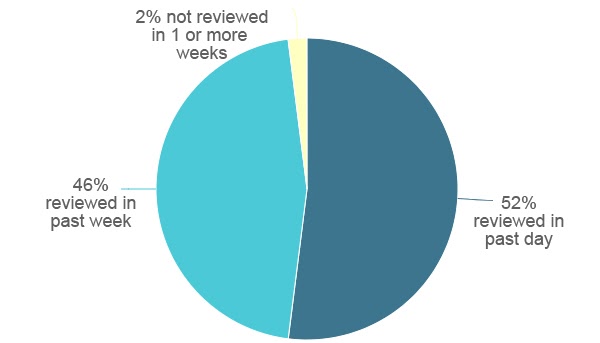
The recency of your reviews signals to Google and consumers whether your business is a place of bustling activity or a bit on the quiet side. It’s long been theorized that review recency might have some impact on rank as a user behavior signal. In my data set, 52% of top-ranked stores had been reviewed within the last day. 46% had received a review within the last week. Only 2% had seen more than a week go by without receiving a new review.
Takeaway: Multiple consumer surveys have found that customers tend to be most interested in your most recent reviews when making a decision about where to shop. If a grocery store location you’re marketing hasn’t been reviewed in weeks or months (or years!), it’s definitely a signal to begin actively asking customers for feedback.
Always remember that your customers are your grocery store’s best sales force. They freely convince one another to shop with your company by dint of what they say about your brand in reviews. A steady stream of recent, positive sentiment is priceless sales copy for your market.
Owner responses to reviews in 2020
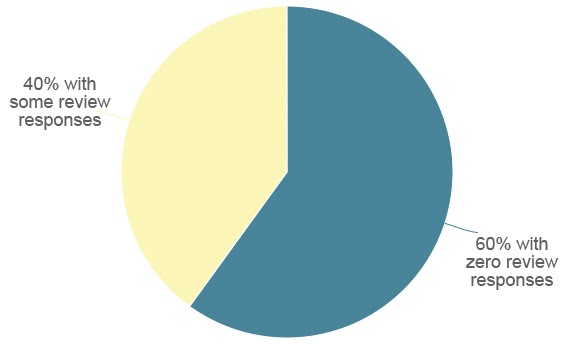
Making use of Google’s owner response function on the reviews a grocery store receives is absolutely basic to providing good customer service. However, in my data set, 60% of top-ranked grocery stores had not responded to a single review in 2020, and of the 40% that had responded to some reviews, not one brand had responded to all of their reviews.
Takeaway: While ignoring reviews appears to have had no negative impact on grocery stores’ ability to achieve top local pack rankings, I can’t emphasize enough what a waste of opportunity is happening in this vertical.
Every review is a customer starting a conversation with a brand, whether their goal is to thank the business or to complain in hopes of receiving help. Ignoring the majority of conversations customers are starting must be extremely deleterious to consumer satisfaction and reputation. 2020 was a year like no other, and grocers have had their hands full adapting and surviving, but going forward, supermarkets that allocate resources to responding to every review will have an incredible customer experience edge over less-engaged competitors.
Place topics
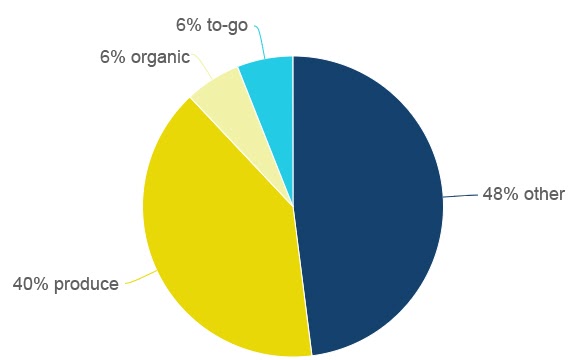
Google excerpts common topics from the body of each store’s reviews and puts them at the top of the review display. 40% of top-ranked grocery stores have “produce” as their most-mentioned place topic, and it was also present for many, many other stores even if it wasn’t their #1 topic. 6% have “organic” and another 6% have “to go” as the most-talked about element, but beyond this, place topics are greatly varied. This area of Google’s interface is sprinkled with terms like “clean”, “cashier”, “deals”, “sales”, and many other words.
Takeaway: I’m not yet convinced of the usefulness or ultimate staying power of this aspect of Google’s review displays. However, it provides very shorthand sentiment analysis for grocers and marketers wanting an at-a-glance idea of what customers are saying in reviews for a brand and its competitors. You need to drill down into the text of the reviews, though, to see whether frequent mentions of something like “clean” are from customers saying a business is or isn’t clean. Place topics just aren’t terribly sophisticated sentiment analysis, at this point.
My data set reveals that Americans are putting premium focus on produce, so one takeaway here is that the quality of your produce department drives consumers to leave reviews. A great produce department could lead to a great rating and great consumer-created content about your market. A disappointing produce section could create the reverse. I also found the prevalence of “organic” place topics revealing, given stats I had seen on the 10X growth in purchases of organic produce between January and March of 2020. There is a clear demand trend here for healthy food that should be informing inventory.
Price attributes
Google places a 1-4 point “$” attribute on many listings as an evaluation of costliness. It’s believed these designations stem, in part, from attribute questions Google asks users, but the overall data set is incomplete. In my sampling, Google only had a price attribute for 42% of the top-ranked grocery stores. Of that number, 76% were marked with the moderate “$$” price attribute.
Takeaway: As I found in my previous piece on The Google Characteristics of America’s Top-Ranked Eateries, neither Google nor consumers tend to consider either the cheapest or most expensive food options to be the most relevant. Concepts of thrift and spendiness differ greatly across the US, but it’s good to know that a modest price evaluation tends to correlate with top local rankings. That seems to be in-step with the current economic picture. The grocery brands you’re marketing don’t need to be the cheapest or the most expensive; the ideal would be delivering good value for a reasonable price.
Google Posts usage before and during COVID-19
Google Posts are a form of microblogging that enables brands to post fresh content to their Google Business Profiles. Prior to the COVID-19 pandemic, 24% of grocers were publishing Google Posts, but in 2020, only 16% were actively making any use of this feature.
Takeaway: Google offered special COVID-19 post capabilities to businesses in 2020, but top-ranked grocery stores largely ignored this opportunity. Pre-pandemic usage was very meager, with only about a quarter of grocers using Google Posts to boost engagement. The 8% falloff in 2020 may paint a picture of a vertical too preoccupied with other, more urgent priorities to give this feature a try.
Use of Google posts is not believed to impact ranking, and neglect of this feature clearly didn’t hold any of the subjects back from achieving top rankings, but if a brand you’re marketing can allocate resources to this type of publishing, it’s worth trying. Moz Local can help you publish Google Posts to your listings, and increase the opportunities for consumers to engage with your profiles.
Google Questions & Answers

Google Q&A is a Google Business Profile function that lets a company publish and answer its FAQs, as well as letting the public ask and answer questions. Cumulatively, the fifty grocery stores in my survey have received 1,145 questions. The highest number of questions for a single location is 192, and the lowest is two.
Just 14% of grocers have responded to any of the questions their stores have received, and in no case had a grocery store responded to all of its questions.
Takeaway: The majority of the questions I saw were leads — customers asking if a market had this or that product, or offered a particular service or amenity. Sadly, public answers, often left by Google’s Local Guides, were often flippant and barren of information to help the customer making the query. While Q&A is not believed to have any impact on rankings, ignoring customers is not consistent with goals of providing excellent customer service.
Moreover, ignoring leads has a monetary context. One source estimates that the average American grocery trip bill is $60. This means that the total number of questions in my survey, if answered, could bring in $68,700 for that pool of stores. However, in my household, the average grocery bill is about $150 per trip, which could make answering this many questions in California worth something like $171,750, if the shops have the goods and services the customers are seeking. My numbers are just estimates, but one thing I know is that few brands can afford to leave money on the table.
I would highly recommend that grocery stores make the time to populate Google Q&A with their top FAQs, including whether the business offers delivery, curbside service, and requires mask-wearing. Beyond this, using a product like Moz Local will let you know each time a new question comes in at any of your locations, so that you can be sure no potential customer is being ignored and that all leads are the subject of careful stewardship.
The COVID-19 adaptations top-ranked grocery stores have made
Beyond analyzing the GMB listing elements in my data set, I phoned each of the grocery stores to ask them a few questions to understand how they have adapted fulfillment and policies in response to the pandemic.
I could have relied on the Google attributes depicting curbside and delivery service, but I’m glad I made the calls, because I found discrepancies in use of these attributes and actual services provided. In some cases, stores with these amenities had not been tagged with these attributes yet, and in others, the attributes that were displayed were wrong.
These are my findings:
Home grocery delivery
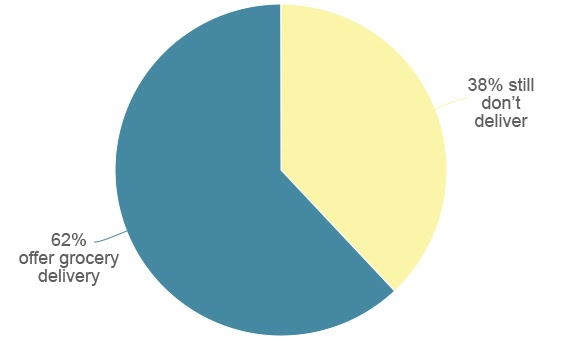
62% of the stores in my survey set are now offering home grocery delivery. I was surprised that this number wasn’t higher, given consumer demand for the safest ways to keep their households supplied, coupled with the clear need to keep grocery workers as safe as possible.
Of this number, only 12% of grocery stores I spoke with have managed to create an in-house delivery service. 31 of the 50 brands in my data set were having to go with the costly option of third-party last-mile fulfillment. Of this number, 29% are using Instacart, 26% are using Doordash, 8% are using Amazon Prime, 4% are using Peapod and Shipt, and 2% are using Grubhub. Three brands were partnering with more than one third-party service, and two were offering both third-party and in-house delivery options.
Finally, I saw multiple instances of Google allowing third-party fulfillment companies to advertise on the Google Business Profiles of grocery stores. Grocery store staff who told me they had no delivery service are almost certainly unaware of this practice. I find this scenario to be one of the least-acceptable in Google’s local playbook, particularly because they place the burden on business owners to try to get such advertising removed from their listings.
A business working hard to develop an in-house delivery team doesn’t deserve to have Doordash or Instacart or Grubhub parked on their listing, eating away at profits. Be sure you’re checking the Google Business Profiles of any grocery stores you’re marketing and seeking removal of any third-party links you don’t want.
Google Trends recorded the massive spike in searches related to grocery delivery that occurred in spring of 2020 as Americans sought strategies for keeping their households supplied while staying safely at home. When you couple this with the tragic reporting UFCW has been offering on the COVID-19 mortality of grocery workers, increasing delivery options is essential.
Keeping the majority of the public at home and limiting face-to-face contact for grocery store staff has made home delivery a vital COVID-19 adaptation that must expand beyond the 62% adoption rate I saw in my study.
Curbside service
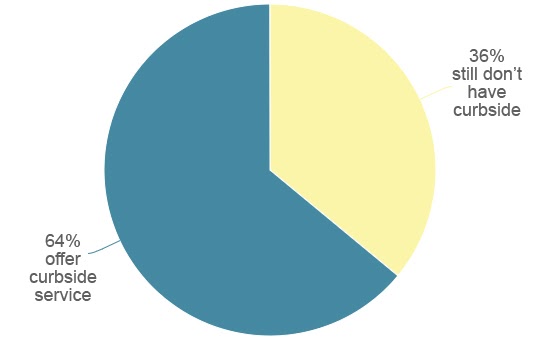
For brands that are still struggling to develop a workable delivery program, curbside pickup has been a welcome option. 64% of the stores in my study are offering curbside service now — a number just slightly higher than the home delivery figure. I saw that in multiple cases, brands that weren’t yet set up to do delivery were at least able to create this fulfillment alternative, but we’d need to see this figure at 100% to ensure no one has to walk into a grocery store and risk infection.
Mask policy
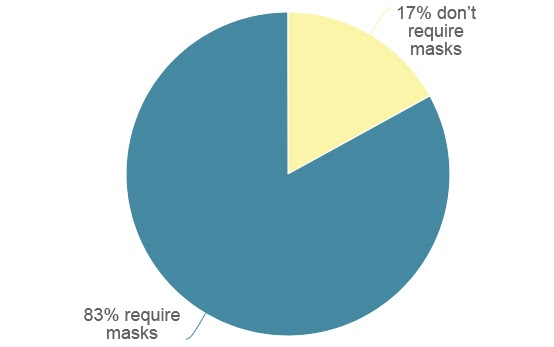
When I asked grocery store staff if their location required all employees and shoppers to wear masks, 83% said yes and 17% said no. This was the most important question in my survey, given the state of the pandemic in the United States, and I want to share what I learned beyond the numbers.
- In the cities/states where grocery store workers reported no masking requirements, they invariably told me they “lacked the authority to enforce mask-wearing”. Lack of government policy has left the people in these communities helpless to protect themselves.
- Reviews sometimes told a different story for the 83% of grocery stores where employees told me masks are required. Despite a stated mask-requirement policy, reviewers report instances of encountering unmasked staff and patrons at some locations and express distress over this, sometimes stating they won’t return to these venues. This means that the actual enforcement of PPE-wearing is actually less than 83%.
- On a purely human level, I sensed that my question about masking made some employees anxious, as if they feared a negative response from me when they told me that masks were required. I can only imagine the experiences some of these staff members have had trying to cope with customers refusing to protect themselves and others from contagion. The exchanges I had with staff further cemented my understanding of the need for clear, national policy to reduce and, hopefully, eliminate COVID-19 so that everyone in our local communities is safeguarded.
My friend and colleague Mike Blumenthal has done the best job in the local SEO industry documenting consumer demand for masking as evinced in reviews, and also, how to get political rant reviews from anti-maskers removed from your GMB listings, should the store you’re marketing receive them. Out of my deep concern for grocery store workers and communities, it’s my strong hope that national leadership will result in 100% participation in grocery industry masking requirements in 2021.
Full contactless fulfillment
0% of the grocery store brands in my study have switched to contactless-only fulfillment, but this methodology may become essential in overcoming the public health emergency. When grocery stores can operate as warehouses where food is stored for curbside pickup and delivery, instead of any in-store shopping, workers and customers can substantially reduce contact.
When the COVID-19 pandemic first emerged in America, markets like Oneota Community Food Coop in Decorah, Iowa switched to pick-up-only for a time, and may need to do so again. Meanwhile, my neighbor is receiving her complete grocery delivery every week from Imperfect Foods, which launched in San Francisco in 2015 and has experienced phenomenal expansion in the past few years on its mission to deliver economical foods in a convenient manner. This comes on the heels of the meal kit delivery bubble, encompassing Blue Apron, HelloFresh, Purple Carrot, and many other options. Even convenience stores like 7-11 are making a strong effort to go contactless.
In April of 2020, 40 million Americans placed online grocery orders. Rapid adaptation is absolutely possible, and until COVID-19 can be placed in the country’s rearview mirror, a national effort may be essential to recast grocery brands as curators of food delivery rather than places to shop in person. Local search marketers should fully participate in grocery store client ideation on how to shape public perception that supports safety for all.
Satisfaction, reputation, and rankings
Delivery, curbside service, and strict masking policies may not seem to have a direct connection to local search rankings, but in the larger scheme of things, they do. Customers reward businesses they love with positive reviews. When a customer is extremely satisfied with how a business like a grocery store takes care of them, studies show this motivates them to award reviews as a thank-you.
The more you demonstrate to customers and communities that the grocery store you’re marketing cares for them, the more you’ll grow your corpus of positive reviews with high star ratings. This, then, will support the local pack ranking goals you’re hoping to meet for maximum online visibility. And your reputation will have become the sort that generates high conversions. 79% of shoppers say contactless pickup is very important to them — whatever you can do to deliver satisfaction to the consumer majority is a very smart move.
What I’ve learned about agility from grocers and their marketers
“There shouldn’t be a brand between you and your customer. You shouldn’t be introducing them to somebody else and nobody should own your information.” — Brian Moyer, CEO, Freshop
It’s not overstating the case to say that the grocery industry is undergoing a revolution. Annual online grocery sales in the US increased from $1.2 billion in August of 2019 to $7.2 billion in June of 2020.
As a local SEO, I can’t think of another industry I can learn more from about adaptation, ingenuity, and resilience. I’ve been following food industry news, and was especially engaged by a webinar I tuned into hosted by digital grocery software provider, Freshop. I’ll summarize seven key takeaways here:
1) If you can develop an in-house delivery program, do it, because it’s the only way to maintain ownership of the full customer experience with your brand. It also makes financial sense in the long run, as I covered previously here in my column on Third Party vs. In-house delivery: A Guide to Informed Choice. In the Freshop webinar, Brian Moyer reminded attendees that Blockbuster once had the opportunity to buy Netflix, but passed on the chance. Now is the time for grocery stores to protect themselves from giving their trade away to the Instacarts and Doordashes on the scene.
2) Whatever software you use to digitize your grocery inventory, it should be strong on POS integration, inventory management, and analytics. I was impressed with the short demo I saw of Freshop’s analytics dashboard coverage of pick times and slot fulfillment for delivery management, profitability across time, tracking of both non-transactional and transactional behaviors, and integration of Google Analytics for measuring conversion rates.
3) Take a page from meal kit services and offer them yourself. Create breakfast kits, supper kits, dessert kits, holiday meal kits, etc. Make it easy for customers to think in terms of meals and get everything they need in a couple of clicks.
4) Consider leveraging digital ads on your grocery store website from brands you already carry. This can create an additional revenue stream.
5) Create online shoppable circulars. Remember that I saw “deals” and “sales” showing up as GMB place topics? Many customers who used to take cues from print circulars can learn to transfer this habit to clickable digital circulars.
6) Carefully evaluate the community support options of the digital shopping software you choose. Most grocery stores aren’t direct competitors and can help one another out. A great example I saw was how one grocer shared the letter he wrote to apply for taking SNAP payments. He was happy to let other grocers copy this form letter to use for their own applications.
7) Celebrate the fact that online commerce has removed historic barriers to customers locating store inventory in a complex floor plan. With a search box, any customer can find any product in any aisle. As difficult as things are right now, this is one silver lining of genuine value to grocers and their marketers.
Summing up
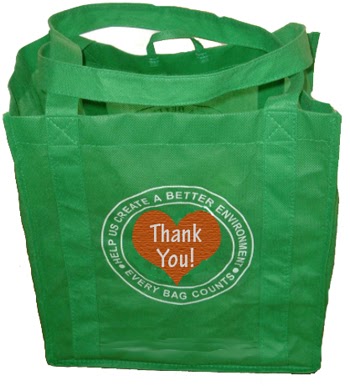
The dominant characteristics of Google’s top ranked grocery stores in the 50 US capitals are:
- Being located in the city specified in the search
- Accomplishing GMB landing page PA in the 40 range
- Not relying on spamming GMB business titles
- Using “grocery store” as their primary category
- Winning a 4+ star rating
- Being heavily reviewed and having received a review in the last week
- Receiving leads in the form of Q&A
- Offering delivery and curbside shopping options
- Requiring masks
The key areas of GMB opportunity that are not yet being utilized by this group to protect dominant visibility are:
- Customer service in the form of review responses
- Lead management in the form of answers to Q&A
- PR in the form of Google Posts
The grocery industry is undergoing a period of significant challenge and opportunity encompassing:
- The challenge of digitizing inventory
- The challenge of managing the full consumer experience with delivery and curbside service to avoid being cut out by third parties and to greatly increase safety
- The opportunity of selling to customers in new ways by fulfilling new needs
- The opportunity of building permanent loyalty by creating memorable experiences of care and satisfaction during the pandemic that will inform post-pandemic relationships
I want to close with a thank-you note to my favorite, great-hearted neighborhood grocer — a family-owned country store in a rural area. You found me ice during a power shutoff in the midst of a fire, you found me bath tissue during the shortage, and locally-distilled hand sanitizer to keep my family safe. You set up curbside pickup to protect me, and when my car was out of service, your family offered to bring groceries to my home, even though you don’t yet have the staff for a full delivery service.
My grateful loyalty is yours.
As a local search marketer, I may look at data, I may share numbers, but really what I’m thinking about is people. People feeding the nation, deserved of every protection and safeguard ingenuity can devise to get us through these hard times together. If you’re running or marketing a grocery store and have local SEO questions, please ask them in the comments and I’ll do my best to provide helpful answers to support your success. Thank you for all that you’re doing!
Sign up for The Moz Top 10, a semimonthly mailer updating you on the top ten hottest pieces of SEO news, tips, and rad links uncovered by the Moz team. Think of it as your exclusive digest of stuff you don't have time to hunt down but want to read!
![]()


Recent Comments